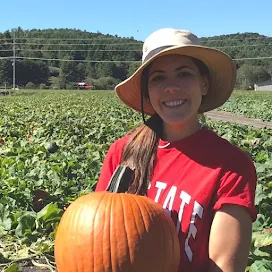Kim Heagy is a graduate student working on a Masters degree in the Department of Horticultural Science at North Carolina State University. Kim is a member of the Schultheis Vegetable Production lab which is part of the CucCAP Integrated Disease Management Team.
Who is your major professor and who are members of your committee?
My major Professor is Dr. Jonathan Schultheis. Members of my committee are Dr. Jason Ward and Dr. Melinda Knuth.
What is your hometown?
Hershey, Pennsylvania

Kim Heagy in the pumpkin research plots.
What is the focus of your work?
Crop management, Integrated disease management, and Precision Agriculture.
Introduce yourself—your background, where you are now, and your current research focus.
I grew up on a family owned orchard and spent my summer picking peaches and apples. I completed my undergraduate degree at Penn State University majoring in Food Science. After working in the industry for a few years as a product developer, I decided to go back to school in order to work more directly with plants. My research focuses on cultural management practices for pumpkins.
Why did you choose to work in horticulture and crop production?
I come from a strong agricultural community and working in horticulture felt so banal to me. I resisted working in agriculture and instead worked in the food science industry after graduating. I enjoyed working as a food scientist in a lab, but I would look out the window from my desk and long to be outside. I choose to work in horticulture because I love food commodities and caring for plants. I also enjoy being outside and working with my hands. It feels like coming home to be working in horticulture.
What do you hope to accomplish during your time working on the CucCAP grant, and what do you most look forward to in this position?
I hope to provide growers with tangible resources for effectively growing pumpkins. Additionally I hope to provide insight to the accuracy and application of precision agriculture software to the pumpkin industry.
Please provide a brief description of your research.
My research focuses on three areas: plant spacing, nitrogen rates and Unmanned Aerial Vehicles (drones) usage. The plant spacing study focuses on the impact of fruit yield based on plant spacing and between-row distance. The nitrogen rate study looks at the optimal nitrogen rate for pumpkin yield. Lastly, the drone study seeks to understand how drones can be used to predict fruit yield and detect disease.
What is your favorite crop?
My favorite crop is cacao! I grew up in Hershey, worked for Mars Chocolate, and have quite a large sweet tooth. I am intrigue by all of the steps that transforms a cacao pod into my favorite treat.
